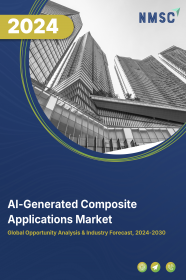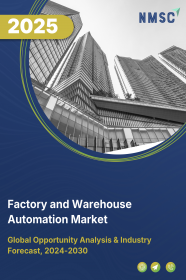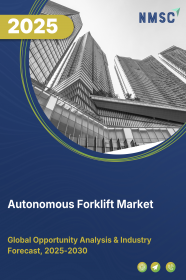
AI-Generated Composite Applications Market by Product Type (Hardware, Software, and Services), by Deployment Mode (Cloud-Based AI Solutions, On-Premises AI Solutions, and Hybrid AI Solutions), and by End-User (BFSI, Retail & E-Commerce, Manufacturing, Automotive, Transportation & Logistics, Healthcare & Life Sciences, Telecommunication, and Other End-Users) - Global Opportunity Analysis and Industry Forecast-2024-2030
AI-Generated Composite Applications Market Overview
The global AI-Generated Composite Applications Market size was valued at USD XXX billion in 2023 and is predicted to reach USD XXX billion by 2030 with a CAGR of XY% from 2024-2030.
AI-generated composite applications or AI software refers to the development and deployment of integrated software applications that utilize artificial intelligence (AI) to combine multiple functionalities or services into unified solutions. These applications leverage AI technologies such as machine learning, natural language processing, and computer vision to intelligently integrate diverse data sources, functionalities, or services from different applications or platforms. They aim to enhance efficiency, automation, and decision-making capabilities across various industries by providing seamless and cohesive user experiences. The AI-generated composite applications market represents a growing trend towards creating versatile and adaptive software solutions that harness the power of AI to address complex business challenges and drive innovation.
Market Dynamics and Trends
The expansion of the AI economy globally is driving the AI-generated composite applications market growth by increasing demand for integrated, AI-enhanced solutions that address complex business needs.
According to the AI Industry Ecosystem Association CIC, the global AI economy is expected to reach USD 32 trillion by 2027, an increase from USD 66.8 billion in 2021. As AI technologies become more advanced and accessible, businesses across all sectors increasingly adopt advanced composite applications that integrate diverse functionalities and data sources for seamless business processes and operational efficiency.
Moreover, the increasing need for automation is another factor driving the AI-generated composite applications market demand by enabling businesses to seek solutions that streamline and optimize complex processes. These applications leverage AI to automate repetitive tasks and provide real-time insights, enabling organizations to enhance efficiency and reduce operational costs.
According to a report by McKinsey published in 2022, companies are making substantial investments in robotics and automation, with automation costs in many industrial sectors expected to account for 25% of capital spending over the next five years. As companies strive to remain competitive in a fast-paced environment, the need for these applications that automate and manage diverse business processes is fueling the industry expansion.
Additionally, the global growth in the data center industry further drives the market by increasing demand for advanced, integrated solutions that optimize data center operations and management. According to the McKinsey & Co., the data center industry of North America is projected to expand from 17 gigawatts (GW) of capacity in 2022 to approximately 35 GW by 2030.
Furthermore, as per the Indian Ministry of Commerce and Industry (MoCI), India emerged as the leading country in data center capacity in the Asia-Pacific region with the demand for Indian data centers projected to range between 650-800 MW during 2024-26.
As businesses increasingly generate and depend on data, AI-generated composite applications play a crucial role by integrating diverse data sources and functionalities for enhancing overall efficiency and performance.
However, developing and integrating automated software composite applications requires significant investment in technology, expertise, and infrastructure, that presents a significant barrier to the AI-generated composite applications market expansion.On the contrary, the adoption of explainable AI (XAI) is expected to create future opportunities in the market by enhancing transparency and trust in AI systems. XAI will facilitate better integration of AI technologies into existing workflows and decision-making processes. It will open avenues for developing more robust and ethical AI applications, thereby, expanding the scope and adoption of AI-powered software integration across various industries.
Market Segmentations and Scope of the Study
The AI-generated composite applications market report is segmented on the basis of product type, deployment mode, end-user, and region. On the basis of product type, the market is divided into hardware, software, and services. On the basis of deployment mode, the market is classified into cloud-based AI solutions, on-premises AI solutions, and hybrid AI solutions. On the basis of end-users, the market is classified into BFSI, retail & e-commerce, manufacturing, automotive, transportation & logistics, healthcare & life sciences, telecommunication, and other end-users. Regional breakdown and analysis of each of the aforesaid segments include regions comprising North America, Europe, Asia-Pacific, and RoW.
Geographical Analysis
North America dominates the AI-generated composite applications market share and is expected to continue its dominance during the forecast period. This is attributed to the growing AI adoptability in the U.S. and Canada boosting demand for integrated, AI-powered solutions that enhance functionality and streamline complex business processes.
According to the United Nations Industrial Development Organization (UNIDO) 2022, the U.S. has the largest number of successful startups in the AI sector. Moreover, both the U.S. and Canada stand as world leaders in AI adoptability, with the U.S. securing the top rank globally and Canada ranking 5th. As more industries leverage AI, the demand for advanced composite applications continues to rise, propelling the overall market growth.
Moreover, the growth of the market is propelled by a robust technological sector in the North American region, that provides a solid foundation for innovation and development. According to the United Nations Industrial Development Organization (UNIDO) 2022, USA secures the top rank globally in the technology sector, with a technological readiness score of 79.64.
Additionally, Canada ranks fifth in the technology sector, boasting 43,200 ICT companies. Advanced technology infrastructure enables the rapid adoption and integration of AI solutions, fostering the creation of sophisticated composite applications. On the other hand, Asia-Pacific region is experiencing steady growth in the AI-generated composite applications market trends, largely propelled by the expansion of the cloud services industry, that creates demand for scalable solutions that integrate seamlessly with cloud infrastructure.
According to International Data Corporation (IDC), the cloud services industry in India is estimated to reach USD 17.8 billion by 2027, increasing at a CAGR of 23.4% between 2022 and 2027. Cloud services facilitate seamless integration of various AI functionalities, such as machine learning, natural language processing, and data analytics, into composite applications, thereby accelerating the market growth.
Also, the growth of the AI-generated composite applications in the Asia-Pacific region is driven by the growing demand for autonomous driving and advanced driver assistance systems that require sophisticated AI algorithms and composite applications to integrate various data sources.
According to the International Trade Administration (ITA), the Japanese government plans to expand autonomous driving lanes to fifty different locations by 2025, providing a supportive infrastructure for the growth of autonomous driving vehicles. These composite applications process data from multiple sensors (cameras, radar, lidar) to create a comprehensive understanding of the environment to enhance autonomous vehicle safety and performance.
Competitive Landscape
Various market players operating in the AI-generated composite applications industry include IBM Corporation, SAS Institute, Inc., Microsoft Corporation, Alphabet Inc., Salesforce, Inc., Amazon.com, Inc., NVIDIA Corporation, Intel Corporation, SAP SE, and Squirro AG. These companies continue to adopt various development strategies including product launches, partnerships, and others to maintain their dominance in the market.
For instance, in September 2023, Salesforce launched new capabilities for its AI technology, Einstein, that includes Einstein Copilot and Einstein Copilot Studio. The Einstein Trust Layer ensures that the AI solutions are secure and compliant with data privacy regulations, allowing businesses to leverage their own data to improve AI responses without compromising security.
Moreover, in May 2023, IBM launched a new artificial intelligence and data platform called watsonx to help businesses train, tune and deploy AI models, including foundation models and machine learning capabilities. Watsonx enables businesses to harness AI effectively across diverse applications, marking a significant growth in enterprise AI capabilities.
Also, in November 2022, Squirro partnered with Semantic Web Company to create a groundbreaking composite AI solution that combines Machine Learning (ML), Natural Language Processing (NLP), and knowledge graph technology. This solution intelligently augments enterprise decision-making and extracts greater value from data.
Key Benefits
-
The report provides quantitative analysis and estimations of the AI-generated composite applications market from 2024 to 2030, which assists in identifying the prevailing industry opportunities.
-
The study comprises a deep-dive analysis of the current and future AI-generated composite applications market trends to depict prevalent investment pockets in the market.
-
Information related to key drivers, restraints, and opportunities and their impact on the market is provided in the report.
-
Competitive analysis of the players, along with their market share is provided in the report.
-
SWOT analysis and Porter's Five Forces model is elaborated in the study.
-
Value chain analysis in the market study provides a clear picture of the roles of stakeholders
AI-Generated Composite Applications Market Key Segments
By Product Type
-
Hardware
-
Software
-
Services
By Deployment Mode
-
Cloud-based AI Solutions
-
On-premises AI Solutions
-
Hybrid AI Solutions
By End-User
-
BFSI
-
Retail & E-Commerce
-
Manufacturing
-
Automotive
-
Transportation & Logistics
-
Healthcare & Life Sciences
-
Telecommunication
-
Other End-Users
By Region
-
North America
-
The U.S.
-
Canada
-
Mexico
-
-
Europe
-
The UK
-
Germany
-
France
-
Italy
-
Spain
-
Denmark
-
Netherlands
-
Finland
-
Sweden
-
Norway
-
Russia
-
Rest of Europe
-
-
Asia-Pacific
-
China
-
Japan
-
India
-
South Korea
-
Australia
-
Indonesia
-
Singapore
-
Taiwan
-
Thailand
-
Rest of Asia-Pacific
-
-
RoW
-
Latin America
-
Middle East
-
Africa
-
REPORT SCOPE AND SEGMENTATION:
|
Parameters |
Details |
|
Market Size in 2023 |
USD XYZ Billion |
|
Revenue Forecast in 2030 |
USD XYZ Billion |
|
Growth Rate |
CAGR of XY% from 2024 to 2030 |
|
Analysis Period |
2023–2030 |
|
Base Year Considered |
2023 |
|
Forecast Period |
2024–2030 |
|
Market Size Estimation |
Billion (USD) |
|
Growth Factors |
|
|
Countries Covered |
28 |
|
Companies Profiled |
10 |
|
Market Share |
Available for 10 companies |
|
Customization Scope |
Free customization (equivalent up to 80 working hours of analysts) after purchase. Addition or alteration to country, regional, and segment scope. |
|
Pricing and Purchase Options |
Avail customized purchase options to meet your exact research needs. |
Key Players
-
IBM Corporation
-
SAS Institute, Inc.
-
Microsoft Corporation
-
Alphabet Inc.
-
Salesforce, Inc.
-
Amazon.com, Inc.
-
NVIDIA Corporation
-
Intel Corporation
-
SAP SE
-
Squirro AG

















 Speak to Our Analyst
Speak to Our Analyst
























